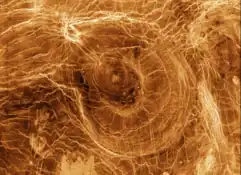Arachnoid (astrogeology)
In astrogeology, an arachnoid /əˈræknɔɪd/ is a large geological structure resembling a spider web. They are of unknown origin, and have been found only on the surface of the planet Venus. They appear as concentric ovals surrounded by a complex network of fractures, and can span 200 kilometers. Over 90 arachnoids have been identified on Venus.[2]

Arachnoids could be related to volcanos, however it is also possible that different arachnoids are formed by different processes.[3] One possible explanation is that an upwelling of magma from the interior of the planet pushed up on the surface, causing cracks.[4] An alternate theory concerning their origin is that they are a precursor to coronae formation.[5]
Much of what is known about arachnoids is the result of studies performed by C.B. Dawson and L.S. Crumpler.[6]
See also
References
- "Planetary Names: Corona, coronae: Trotula Corona on Venus". planetarynames.wr.usgs.gov. Archived from the original on 1 October 2015. Retrieved 26 January 2022.
- Kostama, V.P. (2002). "The Four Arachnoid Groups of Venus" (PDF). Lunar and Planetary Science Conference: 1115. Bibcode:2002LPI....33.1115K – via lpi.
- This article contains text from the Astronomy Picture of the Day . As a work of the United States Federal Government, it is in the public domain.
- "WTP: Venus: Arachnoids". pds.jpl.nasa.gov. Retrieved 2017-04-06.
- Hamilton, Calvin J. "Arachnoids". solarviews.com. Retrieved 2017-04-06.
- Dawson and Crumpler. "Characteristics of Arachnoids from Magellan Data" (PDF). Lunar and Planetary Institute Conference: 383–384 – via LPSC.